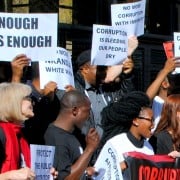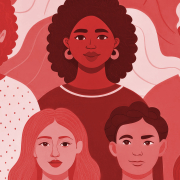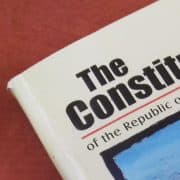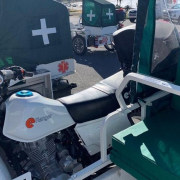|
Getting your Trinity Audio player ready...
|
By Moepeng Valencia Talane – CW Voices
Anyone who regularly reads President Cyril Ramaphosa’s weekly newsletter would be forgiven for assuming that South Africa’s government is on track to make the “better life for all” promised on ANC election posters a reality. But they would also have to be living under a rock, missing the harsh realities that often bite South Africans in the backside, reminding them, especially the less privileged, that the road to emancipation is a long, difficult one indeed.
The latest edition of the newsletter, published on 24 July, sings the praises of the country’s infrastructure development and outlook, boasting that “South Africa ranks in the top five countries in Africa with the best public infrastructure.” It goes on to say how important it is that this infrastructure be regularly and properly maintained to keep its stellar quality.
The president links this need for maintenance to the positive reward that is efficient service delivery. You would swear that, while he also makes mention of the dilapidated railway infrastructure across some of the country’s major economic hubs, he is unaware of the public backlash in response to him presiding over the unveiling of two statues of Nelson Mandela in the Eastern Cape just last week.
The late former president is undoubtedly an essential icon and symbol of unity in a South Africa that continues to struggle with identity and social cohesion, and deserves to have his legacy embedded in all the appropriate social platforms available to do so. However, an honest conversation must be had about what the cost of this should be.
Surely there’s more weight to service delivery-focused spending – especially at this time in our democracy – than for more symbols of struggle icons. Many of those who took to Twitter and other social media and public platforms pointed out that Mandela himself would probably have looked down on the monumentalism, and preferred rather that a celebration of his legacy be linked to improving education sector infrastructure, and not yet another depiction of him.
Mandela statues a-plenty
Of course, the Eastern Cape monuments are not the only ones on the cards. Another Mandela statue, along with one of former ANC president Oliver Tambo, is reportedly earmarked for Durban, with eThekwini Metro Municipality expected to spend R22-million.
Keep in mind that if this amount sounds absurd, it is the same as what taxpayers would have paid for a glow-in-the-dark flag pole that former arts and culture minister Nathi Mthethwa had to backtrack from spending on just last year, when public outrage outweighed his arguments. According to IOL, the three Mandela statues going up this year bring to 40 that have now been erected all over the world. Almost half of them, 19, are in South Africa.
So is it really unreasonable for South Africans to question the thinking behind this latest tribute?
Without a doubt, there was no way of avoiding the country commemorating the internationally recognised birthday of the founding president of a democratic South Africa, but what has baffled many South Africans is the timing of the decision by a government so immersed in countless issues in desperate need of attention. The host province of the statues, the Eastern Cape, is itself facing a number of developmental backlogs and remains in desperate need of development 29 years into democracy.
Granted, it would cost the government far more than the value of the statues in question to address the needs of Eastern Cape communities so desperate for progress in circumstances where close to two million learners were uncertain that they would be supplied with meals a mere three months ago.
Corruption Watch has been reporting on the struggles of the education sector in that province for years, and although there are some improvements, they are so few and far between that little impact is felt on the ground.
Now a decision to erect a statue is not something that is done this week, with implementation starting the next week. The unveiling has been on government’s programme of events for months, if not years, and smacks of an inability to simply read the room. The lack of urgency in how the desperate service delivery challenges impact communities is disheartening to watch.
Take all arguments into consideration
It has been said many times that South Africans are an opinionated bunch, and at times it comes at a cost of being lambasted by politicians defending their poor decisions. We are comfortable with debating everything from reality TV to the contributing factors for freak accidents like the recent Joburg CBD underground blast; the diplomatic crisis with Russia averted ahead of the BRICS event; and countless other issues that arise often. And oh, do they arise often!
The renaming of public roads and buildings after struggle icons has long been one of those issues, and on countless occasions the opinions of South Africans weighing in on whether these are necessary have been abruptly dismissed by government leaders. They’re not always unjustified in defending their position, but there is wisdom in stopping to look at all arguments and agreeing on their varied degrees of merit, when the situation allows.
Approving, planning, and building not one but two statues in the middle of an economic crisis, in a province that has dire service delivery backlogs tells us, the public, that such wisdom did not inform the events around the statues. And now the public backlash is misconstrued to imply that we should abolish all recognition of struggle icons’ legacies, which is not the case.
One Twitter user’s response to the news of the statues aptly summarises our collective sentiment around the decision. He tweets “Let them eat statues”, to symbolise how the voices of the masses are unheard and insignificant in such cases. It is unfortunate, especially because the numerous debates on the topic took our energies away from celebrating Mandela, but also revealed that South Africans genuinely care enough about their country to raise the alarm when things go awry.








